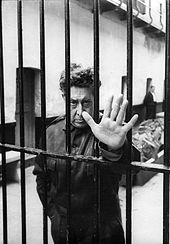| América Tropical: Oprimida y Destrozada por los Imperialismos | |
|---|---|
| English: Tropical America: Oppressed and Destroyed by Imperialism | |
 | |
| Artist | David Alfaro Siqueiros |
| Year | 1932 |
| Type | Mural |
| Dimensions | 18 ft x 82 ft |
| Condition | Restored in 2012 |
| Location | Los Angeles |
| 34°03′28.5″N 118°14′16″W / 34.057917°N 118.23778°W | |
América Tropical is a 98-foot wide fresco mural created in 1932 by David Alfaro Siqueiros and other artists in Los Angeles, California, on a second-level exterior wall of the Italian Hall. [1] It was painted over soon after its completion on an external wall of the Italian Hall on Olvera Street, in El Pueblo de Los Angeles Historical Monument of Downtown Los Angeles. It was restored and revealed to the public in 2012, 80 years to the day after its first unveiling. [2]
History

Siqueiros came to Los Angeles as a political refugee in 1932 and was sponsored by the Plaza Art Center to create a mural that was supposed to be about happy men, parrots, and palms with fruit falling into the mouths of people. [3] However, Siqueiros completely disobeyed the institutional project request in pursuit of his own unique artistic idea by creating his own mural, which turned out to be one of the most controversial art pieces in Los Angeles history, Tropical America (full name: América Tropical: Oprimida y Destrozada por los Imperialismos, or Tropical America: Oppressed and Destroyed by Imperialism). [4]
The mural became the center of controversy, as the painting clearly depicted a Maya-like pyramid with surrounding twisted trees, and in the center was an indigenous person crucified, dead on a double edged cross. There are sculptures lying at the bottom of the mural, destroyed, which signify pre-Columbian architecture and ancient indigenous civilization. [5] On the left side of the pyramid there are two snipers overlooking the imperial American eagle which is on top of the crucified indigenous person and the two Mexican revolutionary snipers look ready to shoot at any time. [5]
América Tropical is an emblematic part of the Mexican muralism movement that happened from the 1920s–1970s and later inspired the Chicano art movement in the United States for Mexican-Americans. Siqueiros also belonged to one of the most elite groups of artists from the Mexican Revolution known as "the big three", along with Diego Rivera and José Clemente Orozco. [6] The three of them went around all over the Americas painting murals that depicted the struggles of people.
Restoration

América Tropical is not only a mural but is also an intricate part of Los Angeles history. As the restoration of Siqueiros' mural continues today, the Getty Foundation, via the Getty Conservation Institute, has spent 3.95 million dollars on a restoration project, while the city of Los Angeles has also contributed 5 million dollars for the conservation of the mural. [7] [1] The project's scope is to conserve, interpret, and provide public access to the mural. [1]
Josephina Quezada and Jaime Mejía were brought in to restore the mural in 1971, but opted to preserve the mural instead of restoring it at that time. [8] [9] At the time, Siqueiros declined the preservation of his mural. [10]
Work has been completed on: documentation, cleaning, reattachment, stabilization, and treatment of the mural; [11] constructing a shelter and viewing platform on an adjacent roof with elevator access; [12] and the América Tropical Interpretive Center. [13] [1]
See also
References
- ^ a b c d Getty.edu: Conservation of "América Tropical"
- ^ Fuentes, Ed (October 9, 2012). Welcome Back, 'América Tropical.' www.kcet.org. Retrieved September 17, 2016.
- ^ Goldman, Shifra M. "Siqueiros and Three Early Murals in Los Angeles." Art Journal 33, no. 4 (1974): 321–327
- ^ Del Barco, Mandalit. "Revolutionary Mural To Return To L.A. After 80 Years". www.npr.org/. NPR Hourly Newscast. Retrieved 25 February 2016.
- ^ a b Goldman, Siqueiros and Three Early Murals in Los Angeles, 324.
- ^ Montgomery, Sara Janelle (May 2017). The Long Arm of the Wall: Mural, Myth, and Memory in América Tropical (Thesis). p. 3. Retrieved September 2, 2020.
- ^ Muchnic, Suzanne. "L.A.'s long-running Siqueiros affair". Los Angeles Times. Retrieved 25 February 2016.
- ^ Davidson, Terry (1982-11-07). "Spartans of Legend CV High Mural". Chula Vista Star-News. p. 12. Retrieved 2017-09-25 – via Newspapers.com.
-
^ Treviño, Jesús Salvador (2001).
Eyewitness: A Filmmaker's Memoir of the Chicano Movement. Houston, Texas: Arte Publico Press. pp.
214.
ISBN
9781611921434.
josefina quezada mural.
- ^ Goldman, Shifra M. (1994). Dimensions of the Americas: Art and Social Change in Latin America and the United States. University of Chicago Press. p. 99. ISBN 9780226301242.
- ^ Getty.edu: Conservation of the mural
- ^ Getty.edu: Shelter and Viewing Platform
- ^ Getty.edu: América Tropical Interpretive Center
External links
- Getty.edu: official Conservation of América Tropical website — homepage with project links.
- América Tropical Interpretive Center — official website